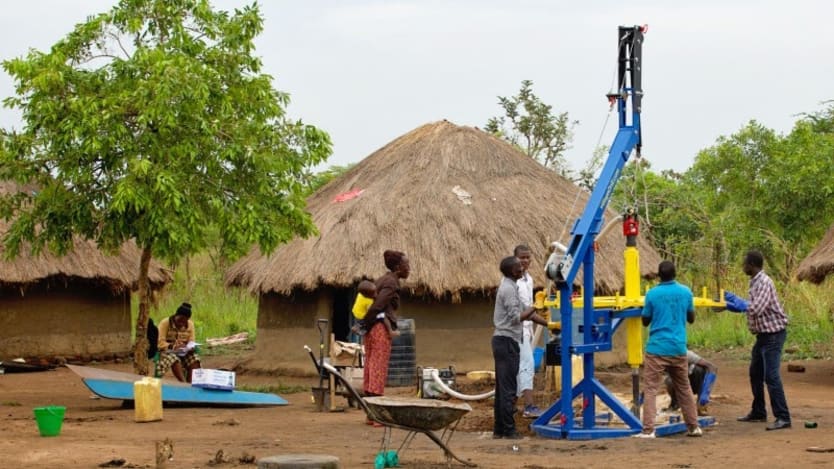
BELFAST, Northern Ireland — Hand-washing and basic hygiene, alongside social distancing, are the world’s best weapons against the coronavirus. Yet for many people, especially those living in remote and rural areas of low- and middle-income countries, clean water remains elusive.
Globally, 1 in 3 people do not have access to safe drinking water, and at least 2 billion use a water source contaminated with feces, which can transmit diseases such as cholera, typhoid, and polio. Contaminated drinking water leads to about 485,000 diarrheal deaths per year. This does not include the effect of other viruses, such as the coronavirus, that simply spread faster when there is limited access to clean water for hand-washing and other hygienic behaviors.
Are water ATMs dispensing a viable solution to clean water?
Water ATMs are increasingly popping up in low-resource settings, but are they really a solution to clean water?
While wells and water pumps are some of the more traditional solutions to providing communities with water, other unique methods are beginning to circulate in the hopes of generating impact.
“For those who are interested in increasing access to water, they should begin by understanding what the barriers to access are and then thinking creatively about how those challenges can be addressed,” said Lauren Cuscuna, innovations and insights manager at the Safe Water Network.
Devex takes a look at some of the innovative solutions already out there.
1. A new way to drill
Installing a well typically requires a drilling rig that can create a borehole deep enough to extract water from the ground. Such rigs are heavy pieces of equipment that cost anywhere between $15,000 and $25,000 to use per well.
But there are other ways to do it. The Village Drill is a lightweight, portable drill that operates using manpower rather than machine power. It was first designed in 2011 by engineers at Brigham Young University in Utah. For a one-off cost of $25,000, it can produce dozens of wells each year. There are now over 105 Village Drills operating in 36 countries, including Somalia, Bolivia, and Papua New Guinea.
“One of the problems with the big rigs is that they can’t get to most of the people who live off approved roads,” said John Renouard, founder of water nonprofit WHOlives and co-creator of the Village Drill.
According to Renouard, the drill takes less than two hours to put together, can drill up to 270 feet, and functions in 75% more areas than a typical drill rig.
When a community gets a Village Drill, WHOlives provides training on how to use it so wells can be drilled independently by community members, who sometimes go on to rent out the drill and their services to other communities as a way of generating income.
“My hope is that people realize there is a solution that's economically viable and doesn’t rely on constant funding,” Renouard said.
2. Warka Tower
Created by Warka Water — a nonprofit that focuses on innovative and sustainable solutions to global challenges — the Warka Tower is a vertical structure made of natural materials that collects rainwater, condensation, and fog before filtering and distributing between 40 and 80 liters of drinking water per day.
“What makes it special is that it is recalling an approach [to collecting water] that was used in ancient cultures but dismissed and forgotten. Today, there is a big need to go back to such sustainable approaches,” said Arturo Vittori, president of Warka Water. “It shows other approaches are possible ... in places like remote villages that are not served by the city pipeline.”
Still in its infancy, the Warka Tower concept has seen three structures built so far in Ethiopia and Cameroon, with plans for additional towers, specifically to support Pygmy people in Ethiopia, Vittori said.
“Structures like this that are independent from governmental infrastructure can help a lot to meet community needs,” he added.
3. Water ATMs
Operating much like an ATM for money, water ATMs dispense clean water when a card — sold by vendors and small shops — is inserted. The ATMs collect rainwater and purify it via solar-powered reverse osmosis or by connecting to the grid system. In Uganda, 1 liter of water from an ATM costs 500 shillings ($0.13). In Bangladesh, it costs 0.4 taka, or less than half of 1 cent.
WaterAid and the Safe Water Network are two of the organizations rolling out water ATMs in some countries.
“It addresses what we call the ‘sustainability gap,’ which is the gap between water revenues and expenses in order to have a financially sustainable model,” Cuscuna said.
“For those who are interested in increasing access to water, they should begin by understanding what the barriers to access are and then thinking creatively about how those challenges can be addressed.”
— Lauren Cuscuna, innovations and insights manager, Safe Water NetworkWater ATMs offer people reliable access to clean drinking water at an affordable price in places such as settlements or remote villages where access may otherwise be difficult. The use of a card rather than cash also makes it easier for organizations such as SWN to compile data on water ATMs’ usage to better meet the needs of communities, Cuscuna said.
While there can be an initial distrust of the machines, Cuscuna suggested that can be remedied by working with communities and explaining how they work.
4. Underground aqueducts
This centuries-old system of water collection goes by varying names, including qanat or kahriz. They are a kind of underground aqueduct or canal, engineered to collect groundwater and direct it to the surface for drinking, domestic use, and agriculture, according to Arzu Musayev, a senior engineering assistant with the International Organization for Migration in Azerbaijan.
Around the 1960s, the introduction of wells meant that many kahrizes were abandoned, but groundwater reserves have since decreased in some areas, making many wells insufficient, Musayev said. To tackle this, IOM is working in countries such as Azerbaijan to rehabilitate the system.
“It is a nonelectric and non-fossil-fuel-consuming method of supplying water. It therefore ensures the protection and improvement of biodiversity, while contributing to the improvement of beneficiaries’ quality of life,” Musayev said.
Since 1999, IOM Azerbaijan has rehabilitated 163 kahrizes, providing water for over 20,000 rural households. Once IOM has helped to restore them, community members are expected to maintain the system. Musayev said promotion, education, and training would help to increase their use.
5. Fog catchers
In the Southwest of Morocco, women-led nongovernmental organization Dar Si Hmad is taking advantage of the often foggy conditions around Mount Boutmezguida to provide water to people who would otherwise have to travel hours each day to the nearest well.
Made of 17,222 square feet of nets held together by two pillars, each catcher captures fog in its honeycomb-like structure before condensing it into liquid. The water then slowly gathers in the gutter below and is transported via pipes to local households.
While the yield can be small and much patience is needed, the quality of the water is exceptional given the lack of pollution in the area, said Jamila Bargach, co-founder and director of Dar Si Hmad. Since a pilot project launched in 2015, fog catchers have been constructed across 16 villages in the area, with immediate plans to reach eight more villages before looking to other locations across West and North Africa.
The access to clean water is having an impact on the area’s agriculture as well, according to Bargach. “We were also given a piece of land by the community, and the organization has turned this [into] a green farm thanks to the excess of fog water,” she said.






